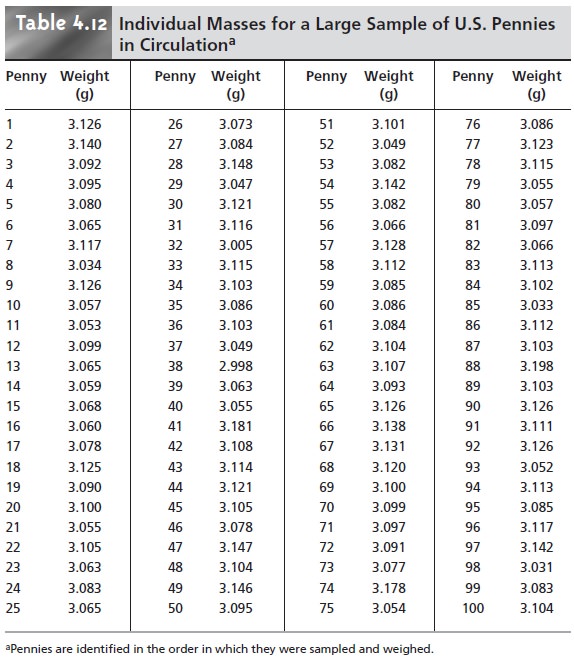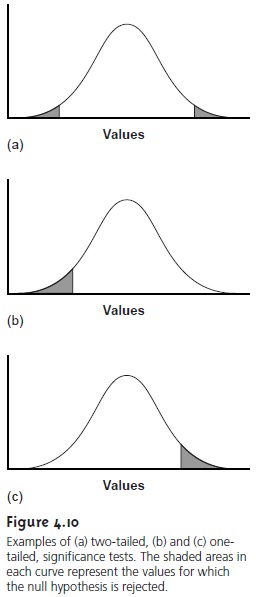Chapter: Modern Analytical Chemistry: Evaluating Analytical Data
Statistical Analysis of Data
Statistical
Analysis of Data
In the previous
section we noted that the result of an analysis
is best expressed as a confidence interval. For example,
a 95% confidence interval for the mean of five re-
sults gives the range in which we expect to find the mean for 95% of all samples
of equal size, drawn
from the same population. Alternatively, and in the absence of de-
terminate errors, the
95% confidence interval indicates the range
of values in which
we expect to find the population’s true mean.
The probabilistic nature
of a confidence interval provides an opportunity to ask
and answer questions comparing a sample’s mean or variance
to either the accepted
values for its population or similar values
obtained for other
samples. For example, confidence intervals
can be used to answer questions such as “Does a newly devel-
oped method for the analysis
of cholesterol in blood give results that are signifi- cantly different from those
obtained when using
a standard method?”
or “Is there a significant variation
in the chemical composition of rainwater collected
at different sites downwind from a coalburning utility plant?” In this section
we introduce a general approach to the statistical analysis
of data.
Significance Testing
Let’s consider the following problem.
Two sets of blood samples
have been collected from a patient receiving medication to lower
her concentration of blood glucose. One set of samples
was drawn immediately before the medication was adminis- tered; the second set was taken several hours later. The samples are analyzed and their
respective means and variances reported.
How do we decide if the medication was successful in lowering
the patient’s concentration of blood glucose?
One way to answer this question is to construct
probability distribution curves for each sample and to compare
the curves with each other.
Three possible out- comes are shown in Figure 4.9. In Figure
4.9a, the probability distribution curves
are completely separated, strongly suggesting that the samples
are significantly dif- ferent. In Figure 4.9b,
the probability distributions for the two samples are highly
overlapped, suggesting that any difference between the samples
is insignificant. Figure
4.9c, however, presents a dilemma. Although the means for
the two samples
ap- pear to be different, the probability distributions overlap to an extent that a signifi- cant number of possible
outcomes could belong to either distribution. In this case we
can, at best, only make a statement
about the probability that the samples
are significantly different.

The process by which we determine the probability that there is a significant difference between
two samples is called significance testing or hypothesis testing. Before turning to a discussion of specific examples, however, we will
first establish a general approach to conducting and interpreting significance tests.
Constructing a Significance Test
A significance test is designed
to determine whether
the difference between
two or more values
is too large to be explained by indeterminate error.
The first step in
constructing a significance test is to state the
experimental problem as a yes- or-no question, two examples
of which were given at the beginning of this sec- tion. A null hypothesis and an alternative hypothesis provide answers
to the ques- tion. The null hypothesis, H0, is that indeterminate error is sufficient to explain any difference in the values
being compared. The alternative hypothesis, HA, is that the difference
between the values is too great to be explained
by random error and, therefore, must be real.
A significance test
is conducted on the null
hy- pothesis, which is either retained
or rejected. If the null hypothesis is rejected,
then the alternative hypothesis must
be accepted. When
a null hypothesis is not rejected, it is said to be retained rather
than accepted. A null hypothesis is re- tained
whenever the evidence
is insufficient to prove it is incorrect. Because of the way
in which significance tests are conducted, it is impossible to prove that a null hypothesis is true.
The difference between
retaining a null hypothesis and proving the null hy- pothesis is important. To appreciate this point, let us return to our example on de-
termining the mass
of a penny. After looking
at the data
in Table 4.12,
you might pose the following null and alternative hypotheses

·
H0: Any U.S.
penny in circulation has a mass
that falls in the range
of 2.900–3.200 g
·
HA: Some U.S. pennies in circulation have masses that are less than
2.900 g or more than 3.200 g.
To test the null hypothesis, you reach into your pocket,
retrieve a penny, and deter- mine its mass. If the mass
of this penny
is 2.512 g, then you
have proved that
the null hypothesis is incorrect. Finding
that the mass
of your penny
is 3.162 g, how-
ever, does not prove that the null hypothesis is correct because
the mass of the next penny you sample might
fall outside the
limits set by the null
hypothesis.
After stating the
null and alternative hypotheses, a significance level for the analysis is chosen. The significance level
is the confidence level for retaining the null
hypothesis or, in other words,
the probability that the null hypothesis will be incor- rectly rejected. In the
former case the
significance level is given as a percentage (e.g., 95%), whereas in the latter
case, it is given as α, where
α is defined as

Thus, for a 95% confidence level, α is 0.05.
Next, an equation
for a test statistic is written, and the test statistic’s critical value is found from an appropriate table. This critical
value defines the breakpoint
between values of the test statistic for which the null hypothesis will be retained
or rejected. The test statistic is calculated from the data,
compared with the critical
value, and the null hypothesis is either rejected
or retained. Finally,
the result of the
significance test is used to answer the original question.
One-Tailed and Two-Tailed Significance Tests
Consider the situation when the accuracy of a new
analytical method is evaluated by analyzing a standard reference material with a known μ. A sample
of the standard is
analyzed, and the
sample’s mean is determined. The
null hypothesis is that the
sample’s mean is equal to μ

If the significance test is conducted at the 95%
confidence level (α = 0.05),
then the null hypothesis will be retained
if a 95% confidence interval
around X– contains μ. If
the alternative hypothesis is

then the null hypothesis will be rejected, and the alternative hypothesis accepted if μ
lies in either of the shaded areas
at the tails of the sample’s probability distribution (Figure 4.10a). Each of the shaded areas
accounts for 2.5% of the area under
the probability distribution curve.
This is called
a two-tailed significance test
because the null hypothesis is rejected for values of μ at either extreme
of the sample’s prob- ability distribution.

The alternative hypothesis also can be stated in one of two
additional ways

for which the null hypothesis is rejected if μ falls
within the shaded
areas shown in Figure 4.10(b) and Figure
4.10(c), respectively. In each case the shaded
area repre- sents 5% of the area under
the probability distribution curve. These are examples of one-tailed significance tests.
|
– |
Errors in Significance Testing
Since significance tests
are based on probabilities, their
interpretation is naturally subject to error. As we have already seen,
significance tests are carried out at a sig-
nificance level, α, that defines
the probability of rejecting a null hypothesis that is true. For example, when a significance test is conducted at α = 0.05, there
is a 5% probability that the null hypothesis will be incorrectly rejected. This is known as a
type
1 error, and
its risk is always equivalent to α. Type
1 errors in two-tailed and one-tailed significance tests are
represented by the
shaded areas under
the probabil- ity distribution curves in Figure
4.10.
The second type of error occurs when the null hypothesis is retained even though it is false and should be rejected.
This is known as a type 2 error,
and its probability of occurrence is β. Unfortunately, in most cases
β cannot be easily calculated or estimated.
The probability of a type 1 error
is inversely related
to the probability of a type
2 error. Minimizing a type 1 error by decreasing α, for example,
increases the likeli- hood of a type 2 error. The value of α chosen for a particular significance test,
therefore, represents a compromise between
these two types
of error. Most of the examples in this text
use a 95% confidence level,
or α = 0.05, since
this is the
most frequently used confidence level for the majority of analytical work. It is not unusual, however,
for more
stringent (e.g. α = 0.01)
or for
more lenient (e.g. α = 0.10)
confidence levels to be used.
Related Topics